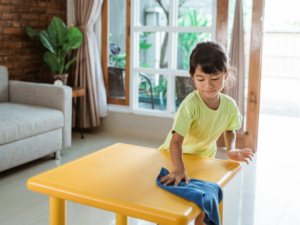Many constipation issues for our children can be dealt with through simple diet and nutrition changes. If your child is dealing with constipation or diarrhea issues, we give you some simple ideas on how to deal with them through what your child eats and drinks.
Constipation
Constipation occurs when your child is unable to or has difficulty passing stool for different reasons, including a poor diet, lack of adequate hydration, medications, fear of needing to poop in a public setting, or a medical problem.
Ideally, children should have a bowel movement 1-2 times per day. Your child may be experiencing constipation if you notice any of the following:
- Abdominal pain
- Belly cramps
- Gas
- Several days without a bowel movement
- Stool accidents in underwear (could be a little or a lot!)
- Poor appetite/low intake
- Grumpy behavior
- Bed-wetting
Constipation can make a limited eater appear even pickier as they will have less of an appetite and may seem more irritable.
Diarrhea
Diarrhea is the opposite of constipation and involves loose, frequent stools. It has many of the same symptoms. You may notice more stool accidents as your child will have the urge to go more often. Your child may also experience nausea. If you see blood or your child has a fever, you should consult your pediatrician immediately.
Avoiding Constipation with Fiber
One of the most important parts of promoting bowel regularity is ensuring adequate fiber consumption. There are 2 main types of fiber. First is soluble fiber which dissolves in water and can help promote regular bowel movements. Second is insoluble fiber which does not dissolve in water but bulks up stool and can increase transit time.
The most recent Dietary Guidelines for Americans lists the following grams per age group for fiber per day:
- 1-3 year olds: 14 grams
- 4-8 year olds: 16-20 grams
- 9-13 year olds: 22-25 grams
- 14-18 year olds: 25-31 grams
Most good sources are in fruits, vegetables, nuts, seeds, beans, and whole grain products are all good sources of fiber. The foods below all have > 5 grams of fiber per serving:
Avocado, raspberries, grapefruit, apple, pear, beans, flaxseeds, peas, kale, sweet potatoes, squash, wheat bran, bran cereal, wheat germ, oat bran, oats brown rice and whole wheat pasta
More Tips to Avoid Constipation
In addition to the amount of fiber, consider the following tips to decrease the likelihood of your child having constipation and promote healthy digestion overall.
- Encourage adequate water intake and limit sugary beverages
- Provide daily sources of probiotics like yogurt, kefir, kimchi, raw sauerkraut, and kombucha. If a child does not prefer these foods, consider using a probiotic supplement with a blend of Lactobacillus and Bifidobacterium.
- Encourage the child to sit on the toilet regularly for a few minutes every day if they are not doing this independently. This can help children to learn and respond to urges to use the bathroom. In addition, it helps them understand the importance of taking time out from play to use the bathroom. Some kids intentionally avoid stopping play when they need to have a bowel movement which can lead to a withholding pattern.
- Address posture while on the potty! Squatting is a more natural position for having a bowel movement. Consider switching to a squatter potty which allows a child’s legs to be in a more ideal squatting position.
- Limit stress. Being more anxious can impact a child’s digestive function and slow it down.
- Supplement with magnesium – consider adding liquid magnesium glycinate, using a magnesium cream, or encouraging Epsom salt baths.
- Encourage your child to engage in regular physical activity. Movement can decrease the likelihood of being constipated.
- Rule out food allergies or food sensitivities. Constipation triggers can vary from child to child.




